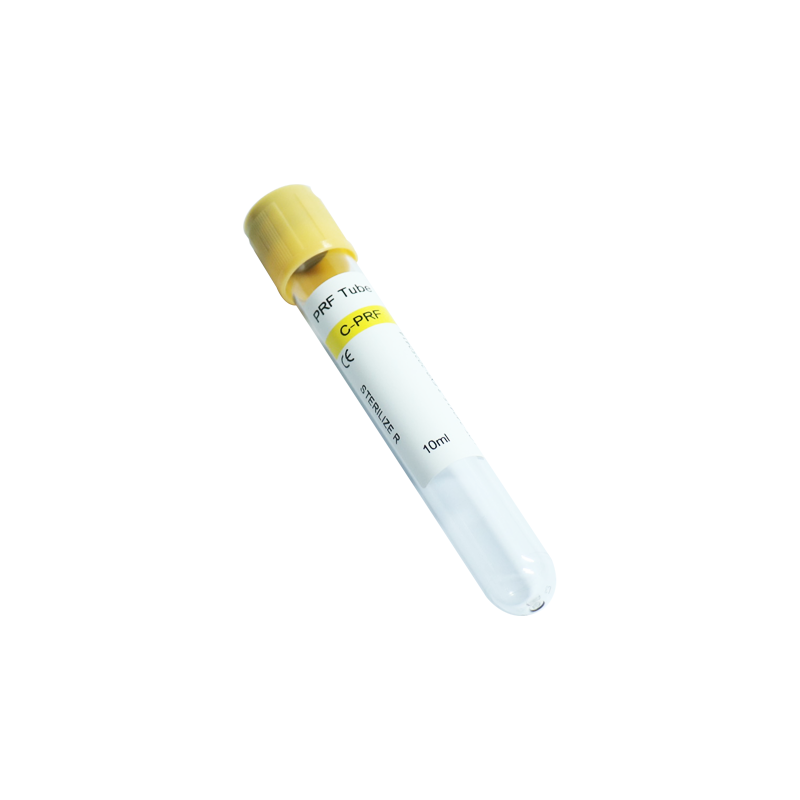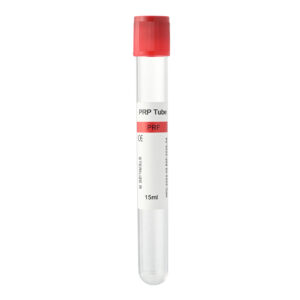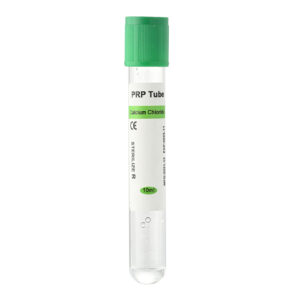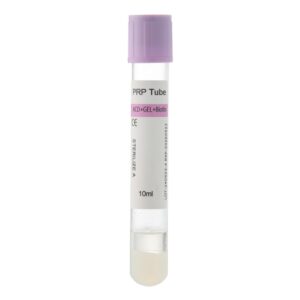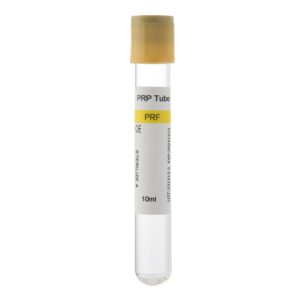Platelet-Rich Fibrin (PRF): PRF is a biomaterial derived from the patient’s blood rich in platelets and fibrin. It is widely used in medical and dental fields to promote tissue regeneration and wound healing. The preparation process of PRF is relatively simple and typically does not require anticoagulants. Centrifugation concentrates platelets and fibrin to form a gel rich in growth factors.
Concentrated Platelet-Rich Fibrin (C-PRF): C-PRF is an advanced version of PRF technology that further concentrates the platelets and growth factors, enhancing its effectiveness in tissue repair and regeneration. The preparation process of C-PRF is more complex, requiring multiple centrifugation steps to remove more plasma and red blood cells, resulting in a highly concentrated fibrin gel. Due to its higher concentration of bioactive components, C-PRF shows stronger effects in promoting tissue regeneration and healing.
Adhibition
Usage of PRF:
- Blood Collection: Collect about 10 ml of blood from the patient’s vein.
- Centrifugation: Process the blood in a centrifuge for about 10 minutes. The blood components separate into layers: plasma on top, platelet-rich fibrin in the middle, and red blood cells at the bottom.
- Collection: Extract the middle layer of platelet-rich fibrin gel, rich in platelets and growth factors.
Usage of C-PRF:
- Blood Collection: Collect more blood from the patient’s vein, usually 20 ml or more, to ensure sufficient platelet concentration.
- Centrifugation: Process the blood through multiple centrifugation steps, with precisely controlled time and speed, to remove more plasma and red blood cells, retaining highly concentrated platelets and fibrin.
- Concentration and Collection: Obtain a highly concentrated platelet and fibrin gel containing more growth factors and white blood cells, enhancing its bioactivity.
Comparison of PRF and C-PRF
Components:
- PRF: Rich in platelets and fibrin, containing a certain amount of growth factors and cytokines to effectively promote tissue repair.
- C-PRF: Higher concentration of platelets, fibrin, and growth factors, with many white blood cells, enhancing anti-inflammatory and anti-infection capabilities.
Preparation Process:
- PRF: Simple preparation process with single centrifugation, no anticoagulants needed, and easy operation.
- C-PRF: Complex preparation process requiring multiple centrifugations and precise control of centrifugation parameters to achieve higher concentrations of platelets and growth factors.
Concentration:
- PRF: Relatively lower concentration of platelets and growth factors, suitable for general tissue repair and regeneration.
- C-PRF: Higher concentration of platelets and growth factors, suitable for complex surgeries and severe trauma repair requiring stronger healing effects.
Application Scope:
- PRF: Suitable for most tissue repair and regeneration situations, such as dental implants, periodontal surgery, and post-extraction wound repair.
- C-PRF: Suitable for medical fields requiring stronger regenerative abilities, such as complex dental surgeries, severe trauma repair, and cosmetic surgeries requiring rapid healing.
Advantages and Application Scenarios
PRF:
- Advantages:
- Simple preparation: Relatively simple process, lower cost, and easy operation.
- High safety: Uses the patient’s blood, avoiding immune reactions and rejection.
- No need for anticoagulants: Reduces interference from external chemicals during preparation.
- Application Scenarios:
- Dentistry: Used in implant surgeries, periodontal surgeries, and post-extraction wound repair to promote bone regeneration and soft tissue healing.
- Orthopedics: Used for wound healing and bone repair, accelerating fracture healing and post-surgery recovery.
- Dermatology: Used for skin regeneration and cosmetic treatments, improving skin texture and reducing wrinkles and scars.
C-PRF:
- Advantages:
- High concentration of bioactive components: Higher concentrations of platelets and growth factors enhance its effectiveness in promoting tissue regeneration and healing.
- Enhanced healing effects: Contains many white blood cells and growth factors, showing stronger anti-inflammatory and anti-infection capabilities.
- Application Scenarios:
- Dentistry: Used in complex dental surgeries such as implants and periodontal regeneration treatments, providing stronger bone regeneration and soft tissue repair.
- Orthopedics: Used for severe trauma and complex fracture repairs, accelerating the healing process and reducing complications.
- Cosmetic Surgery: Used in cosmetic surgeries requiring rapid healing and significant improvement in skin texture, such as skin filling and regeneration treatments.
Differences between PRF and C-PRF
C-PRF (Concentrated Platelet-Rich Fibrin) and PRF (Platelet-Rich Fibrin) are biomaterials that are rich in platelets and fibrin derived from the patient’s blood and are used to promote tissue regeneration and wound healing. The main difference lies in their preparation processes and the concentration of bioactive components. PRF is prepared relatively simply through a single centrifugation step, which separates a gel rich in platelets and fibrin from the blood. This gel contains growth factors and cytokines that effectively promote tissue repair. PRF is widely utilized in dentistry, orthopedics, and dermatology for a range of applications, such as implant surgeries, periodontal surgeries, post-extraction wound repair, wound healing, bone repair, skin regeneration, and cosmetic treatments.
In contrast, C-PRF requires a more complex preparation process involving multiple centrifugation steps to remove more plasma and red blood cells, resulting in a highly concentrated platelet and fibrin gel. Due to its higher concentration of platelets, growth factors, and many white blood cells, C-PRF has stronger effects in promoting tissue regeneration and healing. C-PRF is particularly suitable for complex surgeries and severe trauma repair requiring stronger healing effects, such as complex dental surgeries, severe trauma repair, and cosmetic surgeries requiring rapid healing.
PRF and C-PRF have the advantage of using autologous materials, avoiding immune reactions and rejection risks. However, preparing C-PRF requires more precise operations and equipment control to ensure high-quality concentrates, which may sometimes increase operational complexity and costs. Overall, PRF and C-PRF significantly promote tissue regeneration and healing, and the choice depends on clinical needs and surgical complexity. Choosing the appropriate technique maximizes therapeutic effects and provides patients with safe and effective treatment options.
Conclusion
PRF is a common treatment method with its simple preparation process and wide applicability. At the same time, C-PRF, with higher concentrations of platelets and growth factors, offers stronger tissue repair and regeneration capabilities and is suitable for more complex and rapidly healing clinical situations. Choosing the appropriate technique based on specific clinical needs can maximize therapeutic effects and provide patients with safe and effective treatment options.

